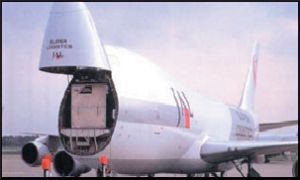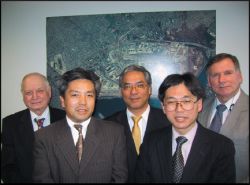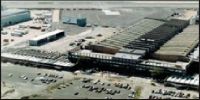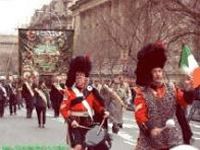|
You are currently
in the Archives section. Please be aware that some information and links
in the archived page may be outdated.
Click here
to return to the Archives' main page to see the list of archived articles.
|
A
R C H I V E S
|


An
Esteemed Mr. Yamamoto Guides
Japan Airlines Cargo, The Americas
Sometimes
as it is said, you can't always see the forest for the trees.
Although it has been there since
1994, Japan Airlines Building 151, which blazed a trail as the
first major modern air cargo construction at JFK International
Airport New York on the passenger side of the airport ten years
ago, remains a wonderworld of high-tech activity.
Inside Building 151, Kazuto Yamamoto,
JAL Cargo Vice President and General Manager, The Americas unlocks
a vision for the 21st Century.
In this first in-depth report from
Building 151, the place emerges from a reputation of a world-class
operation, to its rightful place among the finest air cargo transfer
facilities on the planet.
JAL
Cargo JFK Is Among The Best In The World
 Kazuo
Yamamoto
Kazuo
Yamamoto |
There
may be places that are landscaped better, where the containers are
all lined up by size and color, and they come to attention in a
proper salute when you pass by; where the customer reception areas
are a bit more opulent with piped in music and leather chairs.
But grass cannot grow on a busy street,
containers are too busy to be showcased and who needs chairs for
usually short waiting time?, is a rationale that you are likely
to get from the operators of Building 151 at JFK.
But when it comes to getting what
you really need from a cargo operation including an enviable on
time delivery reputation for companies, with global reach from all
parts of the world, Japan Airlines Building 151 at JFK International
Airport in New York ranks at the top of greatest air cargo operations
on the planet.
After just a few minutes of watching
things develop in the place you come to the realization that what
is going on is like a life within a life.
At the center of the cavernous air
cargo facility lays the heart and soul of the place that JAL Cargo
people and others call, "The System".
The System is an incredibly complex
computer driven materials handling (MHS) set up that pumps traffic
through a 260,000 square foot warehouse with more than 400 airline
pallet positions 2600 roller boxes and a giant fully automated storage
rack system enveloped inside an eleven story tower that is one of
the tallest buildings (other than the control tower), at any airport
anywhere in the world.
But it is "The System" that
people talk about, in almost reverential tones, as if the computer
and its reach by automation to the smallest nook and cranny of the
place were a live breathing person.
Maybe it's not HAL from 2001-A Space
Odyssey movie fame, but click your heels together and believe that
at JAL Cargo JFK is one of the most important and ef. cient air
cargo handling facilities anywhere.
It is hard to imagine that it has
been ten years (July 1994) since JAL Cargo launched the first fully
automated MHS to serve its main gateway for the Eastern & Mid-Atlantic
USA region.
Today, despite a recent building boom
of new air cargo handling facilities up and down both sides of the
Van Wyck Expressway main entrance to the passenger complex at JFK
International Airport, Building 151 remains the most intriguing
technologically advanced operations at the airport.
It should come as no surprise to anyone
who has paid attention to the cargo activities of JAL for the past
decades that in 2004, the carrier and several companies that use
Building 151 would be served by a dedicated super terminal.
Long ago when JAL introduced freighters
across the Pacific route into New York, the carrier set up operations
from the get-go using advanced state-of-the art technologies at
old Cargo Building 263 at JFK.
Today this Building 151 opus is a
carry forward of a tradition of high-tech excellence that has been
a hallmark of JAL Cargo growth in the USA for more than 25 years.
Kazuto Yamamoto, Japan Airlines Vice-President
and General Manager Cargo, The Americas puts high emphasis on the
importance of service delivery.
"The freight forwarders comprise
99 percent of our business. Everything we do is directed toward
providing the best quality for our service partners.
 First
Were The Wright Brothers At Kitty Hawk, Now It's The JAL Cargo
Team At JFK. Pictured are some of the people that have teamed
up to keep JAL Cargo out front during the 21st Century.
First
Were The Wright Brothers At Kitty Hawk, Now It's The JAL Cargo
Team At JFK. Pictured are some of the people that have teamed
up to keep JAL Cargo out front during the 21st Century. |
"JAL
Cargo knows that we must always hold up our end of the shipping
process, by delivering a predictable and thoroughly transparent
supply chain for our service partners.
"Our goal to achieve long-term
business partnerships, based on trust and mutual respect.
"That's why we have put so much
of our resources into creating the best cargo system.
"But our business in 2004 must
be considerate of each other.s particular demands.
"For example, security is paramount
in today's business environment. Screening of air cargo will only
become more intense in the months and years ahead.
"As new technologies race to
meet even tougher government criteria, every part of the cargo business
must pitch in and do their part to share both the expense and responsibility
for this "new normal" in the air cargo experience."
We are speaking in a bright window
walled of. ce upstairs inside Building 151.
As Mr. Yamamoto speaks, just off in
the distance about 15 miles away outlined against a gray winter
morning is the skyline of lower Manhattan with its jumble of buildings
and strange void that was left when the Twin Towers disappeared
on 9/11/01. We imagine that the esteemed chief of JAL Cargo USA
has also surveyed that vista more than once during the past years.
"Everyone knows that security
is a big headache for the customer, the forwarder and the airline
as well.
"Opening up pallets and providing
X-Ray technologies for government regulators was never part of anyone's
business plan.
"But Japan Airlines is determined
to meet and exceed all security standards; to make our air cargo
product not only the best handled and delivered, but also the safest
in the skies."
But technologies and safety concerns
addressed, when it comes to air cargo it.s the product that takes
center stage and at JAL Cargo the latest to come into vogue is "JSpeed".
Actually J Speed is only one of an
extended menu of cargo-specific service offerings, each one part
of a dedicated program of total service of "J" cargo speciic
products that the carrier offers including JArt, JCare and JFresh,
JCool, JFreight to name a few. All are detailed at length on Japan
Airlines Cargo website www.jalcargo.com.
The point is that from wherever Japan
Airlines flies, the cargo division has a dedicated, highly developed,
time-specific cargo delivery system to move and support any commodity.
But at the core of it all, in addition
to a cadre of service professionals in sales and customer service
who on average have spent most of their adult life serving a growing
list of air shippers, Japan Airlines has created advanced super
cargo transfer facilities in Tokyo and Los Angeles and elsewhere,
including the aforementioned one at JFK International in New York.
That MHS, we mentioned earlier, at
JFK is fully automated and makes efficient use of space, reduces
labor costs, provides enhanced security for storage and speeds up
operations.
Shipments are loaded into unit loading
devices (ULDs) of various sizes.
The ULDs are identified by their serial
numbers and are tracked through the system from origin to destination.
When the freighter lands, it is connected by nose dock lifts to
the ULD receiving system. Concurrent with manual loading and unloading
of the aircraft, a computerized control system accepts the ULD into
the automated conveyor system and moves it to a pre-designated position
in the storage system.
A network of distribution conveyors,
transfer vehicles (TVs) and elevated transfer vehicles (ETVs) move
the ULDs to various locations throughout the building depending
on their final destination.
ULDs for immediate breakdown can be
routed directly to work stations.
ULDs to be picked up intact for delivery
to various container freight stations can be routed directly to
automated Pre-Pak docks.
Up to five ULDs can be pre-staged
at each Pre-Pack dock.
Shipments awaiting subsequent pick-up
or breakdown can be directed to the ULD storage area located above
the ULD conveyor system.
The rack-supported structure can store
up to 600 ULDs of various sizes. Roll boxes are used for loose shipments
and travel on overhead roller conveyors (about 20 feet above the
. oor throughout the building.
Roll boxes arrive at floor level by
means of a vertical lift. As with the ULDs, roll boxes are stored
in the roll box rack structure, which is part of the integrated
building storage structure. Shipments are sorted and stored in individual
roll boxes for retrieval at later time. The storage racks can accommodate
up to 3,000 roll boxes.
Currently at JFK, JAL Cargo utilizes
1,700 roll boxes.
Building 151 has greatly reduced the
time it takes to offload and load a 747-F, in fact the place can
handle the operations of up to three jumbos at a time.
The system was designed to completely
turn-around a fully loaded 747-F in one hour and forty-five minutes.
 City
Within The Airport City. Building 151 Is The Only Full Service
Cargo Facility At Any USA Airport. Located on the main entrance
road to JFK International Airport in New York, the Building
151 complex is a city within the airport city, offering a
full range of services including the New York City home of
the Air Couriers Association and several freight forwarders.
Building 151 features the full range of cargo-related services,
including U.S. Customs, plus fulltime medical facilities,
a dentist, expanded service restaurant, and a roster of leading
world air cargo resources, including Finnair, EVA, Japan Airlines,
Malev, and others.
City
Within The Airport City. Building 151 Is The Only Full Service
Cargo Facility At Any USA Airport. Located on the main entrance
road to JFK International Airport in New York, the Building
151 complex is a city within the airport city, offering a
full range of services including the New York City home of
the Air Couriers Association and several freight forwarders.
Building 151 features the full range of cargo-related services,
including U.S. Customs, plus fulltime medical facilities,
a dentist, expanded service restaurant, and a roster of leading
world air cargo resources, including Finnair, EVA, Japan Airlines,
Malev, and others. |
In
addition to being one of the most advance material handling systems,
the facility has integrated computers systems that control the inventory
or cargo shipments. These systems are linked to the U.S. Customs
Automated Manifest System (AMS).
This provides for Custom House Brokers
to pre-clear shipments prior to the arrival of the flights at JFK.
Building 151 has an integrated security
system using the latest technology of CCTV systems supported with
24/7 security guard services.
Storage for high value shipments,
refrigeration, handling of perishables and livestock is supported
within the facility.
JAL Cargo/The Americas is part of
the Freight and Mail Division of Japan Airlines Co., Ltd.
JAL is a member of IATA and was originally
established as the National Flag Carrier of Japan on October 1,
1953.
Today, utilizing a fleet of 138 aircraft
(including 81 Boeing 747s making JAL the largest operator of 747
types in the world). JAL serves some 72 cities in 31 countries and
territories.
Of the 81 747 aircraft, 10 are 747
freighter types, each with a lift capacity of approximately 100,000
kgs.
These freighters operate out of JAL's
New York, San Francisco, Los Angeles, Chicago, Atlanta and Anchorage
gateways to Tokyo and beyond.
Using its worldwide transport network,
and aiming to provide a high level of quality service with safety,
reliability, and speed to anywhere in the world for express and
priority cargo, JAL Cargo joined a global cargo industry alliance
named WOW on July 4, 2002.
In order to achieve its goal, JALCARGO
and three other companies, Lufthansa Cargo, Singapore Airlines Cargo,
and SAS Cargo Group, are creating a worldwide network of 523 locations
in 103 countries, and to build an advanced air cargo logistics system.
Work continues to link up the various
services of each company, standardizing the transport quality, and
integrating computer systems.
Mr. Yamamoto sees potential in the
eventual widening of the WOW alliance.
"An immediate benefit has been
the streamlining of the process for shippers to move expedited cargo
with each other."
"We now have expanded ability
to move certain cargo eliminating costly and time consuming paperwork
and off loading procedures at various points along the supply chain."
"With WOW, a customer makes a
reservation with the nearest JAL alliance partner office, the priority
loading reservation, reservation confirmation, and cargo handling
status confirmation can all be made accurately in real time."
Kazuto Yamamoto has spent 30 years
of his life in service at Japan Airlines, with the past 19 in air
cargo.
He has a big job and a large territory
to cover from pole to pole, the entire Western Hemisphere.
But he views the cargo end of the
air transportation business as most exciting.
"Air cargo is never the same.
"Every day is different and at
times an adventure. “
"This a totally hands on business
that requires new approaches all the time."
When asked what is the most important
driving force for a successful 2004, Mr. Yamamoto wraps that question
up in one simple word.
"Peace. Peace around the world
that will allow all of us to normalize and re-energize our business
efforts to get back to what we do best, improving air cargo service
around the world."
Mr. Yamamoto thinks for a moment and
adds: "Make that peace and quiet."
At that moment somewhere else deep
down inside Building 151 "The System" springs to life.
Mr. Yamamoto smiles.
At once we understand the kind of
peace and quiet the esteemed Mr. Yamamoto is talking about.
|
|

GREAT
DAY IN NEW YORK FOR THE IRISH
May the
road rise up to meet you
And may the wind always be at your back
May the sun shine warm upon your face
And the raindrops fall soft upon your fields
And until we meet again
May God hold you in the small of his hand.
A
GREAT DAY FOR THE IRISH
 There
may be always an Ireland, and beyond that lovely prospect, always
100 parades around the world to celebrate March 17th. There
may be always an Ireland, and beyond that lovely prospect, always
100 parades around the world to celebrate March 17th.
But from 11:00 a.m. until about
3:00 p.m. on an island called Manhattan, where a green stripe
runs down the middle of Fifth Avenue from 44th to 86th Street,
The St. Patrick’s Day Parade is one of New York City’s greatest
traditions.
On St. Patrick’s Day, a kind of
wonderful delirium takes over in Gotham.
Everyone is Irish!
The annual procession marches up
Fifth Avenue, past St. Patrick’s Cathedral at 50th Street, all
the way up past the Metropolitan Museum of Art at 83rd Street.
The St. Patrick’s Day parade in
NYC began even before there was a United States of America in
1766, when Irishmen from Ireland’s Revolutionary War brought the
tradition here.
Military units continued to march
each year until after the War of 1812, when local Irish fraternal
and beneficial societies began sponsoring the event.
In those days, the parade was quite
small, marching from local Irish meeting halls to Old St. Patrick’s
Cathedral in Lower Manhattan on Mott & Prince Streets.
By 1851, the groups had banded together,
nominating a Grand Marshall and increasing the size of the parade.
This was when the Irish 69th Regiment
(now the 165th Infantry) became the lead marchers, and the Ancient
Order of Hibernians became the official sponsor.
We love St. Patrick’s Day.
It’s when the “Irishrey” of New
York come out in full celebration. Look into the faces of the
uniformed services, especially the NYC Firefighters and you will
get it right away.
We also like that St. Patrick’s
Day Parade remains true to its roots by not allowing floats, automobiles
and other commercial overkill.
Marching great bands, bagpipes fill
the air as more than 150,000 people from all over the country
and the world celebrate the "wearing' of the green" here in New
York.
Speaking of Up The Irish! . . .
Aer Lingus in a spectacular turnaround posted a 30 percent rise
in full-year operating profit for 2003, after realigning itself
as a low-fare player.
Close to bankruptcy in 2001, Aer
Lingus delivered an operating profit of 83 million euros ($103
million) in 2003.
Willie Walsh told reporters that
competition within the European market was "brutal" (in 2003)
and said he expected more of the same in 2004.
"I think we've very successfully
positioned ourselves as a successful, profitable low-fare airline,
but the pressure remains on us -- fares will continue to fall
and that means we have to be aggressive and relentless around
management of our cost base," he told Reuters after a news conference
in Dublin.
The airline's transatlantic business,
posted a record year.
A cost-saving move to a single aircraft,
the super efficient A320, on its European network, is expected
to be completed by the end of 2005.
Aer Lingus said it plans to add
13 new routes in 2004.
P.S.
Just in case you are thinking of slipping off to your favorite
pub later today for a pint and some good cheer to celebrate, take
a real break. Here is some conversation that is not about the
air cargo business.
We
have been thinking as Mel Gibson's movie "The Passion of Christ"
continues to set box office records, that aviation is also a heavenly
pursuit. So here in no particular order are some references to
God . . . and flight.
If God wanted
us to fly, He would have given us tickets.
— Mel Brooks
If God had
meant Icarus to fly, she would have given him a cloudy day.
— Leon M. Wise
If God had
really intended men to fly, He'd make it easier to get to the
airport.
— George Winters
God would
surely never allow such a machine to be successful, since it would
cause much disturbance among the civil and political governments
of mankind . . . no city would be proof against surprise . . .
or ships that sail the sea. . . . Houses, fortresses, and cities
could thus be destroyed, with the certainty that the airship would
come to no harm, as the missiles could be thrown from a great
height.
— Francesco de Lana de Terzi of Brescia, Italian Jesuit who was
the first Westerner to write on the military uses of aerial attack,
1670
Some late
news . . .
Finnair
said it will return with its winter run from Helsinki to Miami
December 5th until March 31, 2005.
The recently concluded offering
was a big success plus the addition of AY's sixth MD-11 will allow
the great airline to ramp up service just in time for the sun
'n fun crowd from Scandinavia and Northern Europe.
AY serves New York year round and
recently has added Osaka and Shanghai to Singapore, Bangkok, Tokyo
and Beijing in its long-haul network.
United Arab Emirates and Thailand
signed an open skies agreement, allowing full traffic rights to
operate any type of aircraft or flight frequency between the two
countries and beyond . . . KLM returns to daily service between
Amsterdam and Atlanta Oct. 31 which was halted after 9/11.
Emirates' thrice-weekly A340-300
flights Dubai/Shanghai in April goes daily, May 15. Air Arabia,
the “People's Express” of Sharjah, UAE adds Khartoum April 3.
East Side/West Side . . . DLH Cargo
heads east (along with everybody else) MD-11F service April 3
from Frankfurt, but doesn't stop there on an around the world
all-cargo service to seven airports.
From Frankfurt, the freighter drops
in at Kuala Lumpur, then wings its way via Melbourne to Auckland.
After a tech stop in Hawaii, the
MD-11 swings into Los Angeles and beefs up payload in the city
of broad shoulders, Chicago, flying newly discovered low dollar
exchange-generated outbound cargo from USA, nonstop back to FRA.
For the record, Lufthansa has been
flying its freighter the other way into the wind in a globe girdling
opus for the past couple years.
Kitty Hawk Air Cargo, a division
of Kitty Hawk, Inc., received its third consecutive Federal Aviation
Administration (FAA) Diamond Award.
The Diamond Award is the highest
honor given by the FAA.
It recognizes airlines and other
maintenance facilities where at least 25 percent of aircraft maintenance
technicians complete certified training requirements beyond their
initial certification.
To qualify for the award, Kitty
Hawk maintenance and engineering team members completed numerous
hours of additional classroom and hands-on technical training.
"Kitty Hawk is committed to safety.
So, we're honored to receive our third Diamond Award Certificate
of Excellence from the DFW Flight Standards District Office,"
said Daniel Stone, Kitty Hawk's vice president of maintenance
and engineering.
|
|
|

